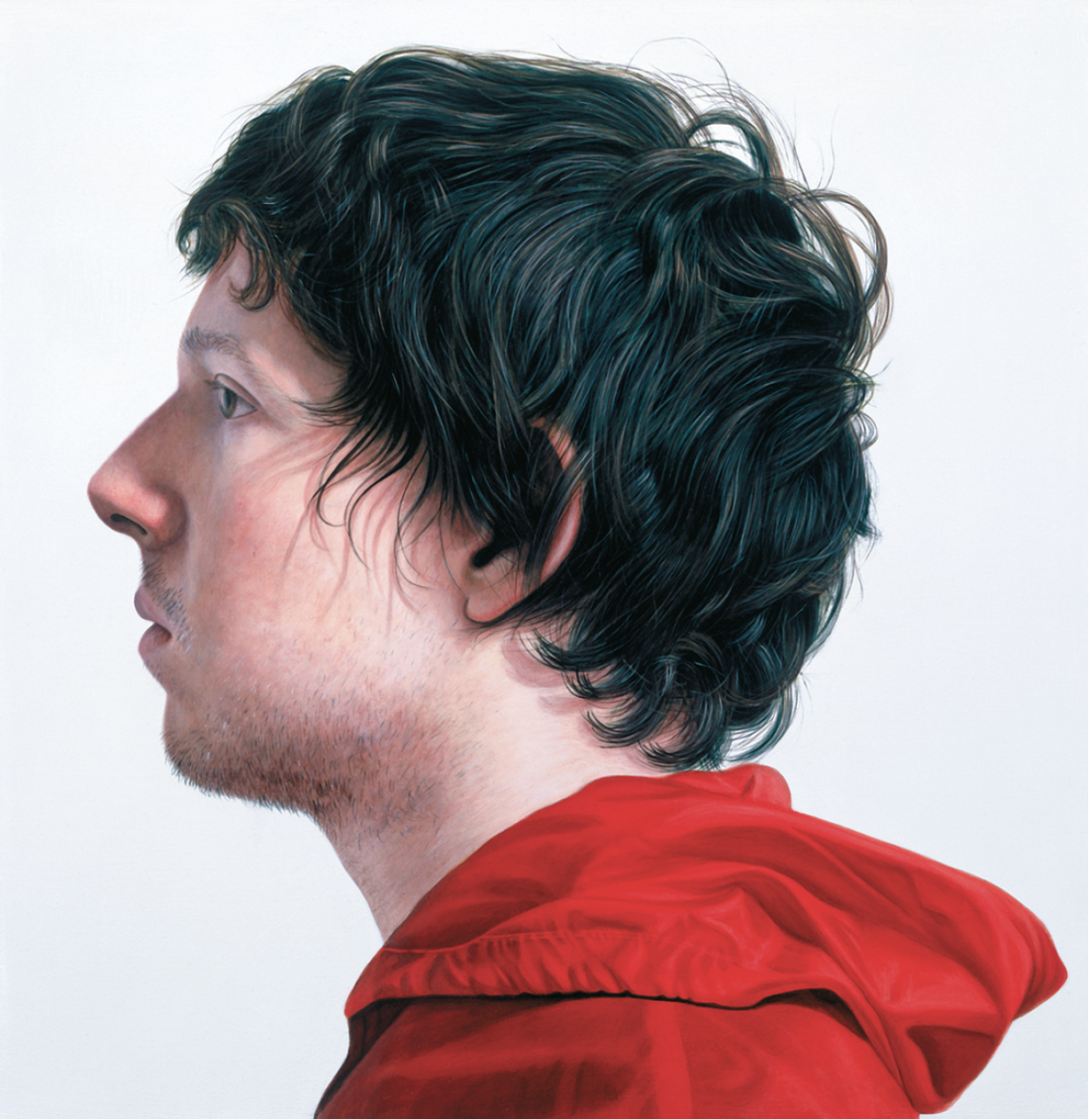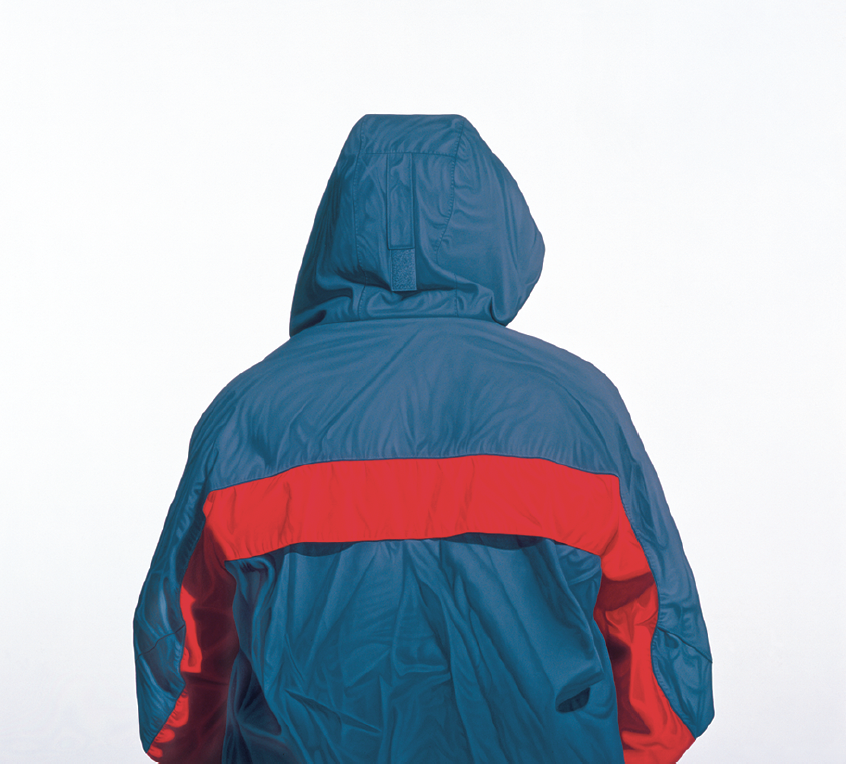Karel Funk
This exhibition of works by the Winnipeg-born and -based painter, Karel Funk, had some surprising revelations in store for those who were not prepared to take the work exhibited at face value. But then, who could look at these exquisitely “photorealistic” works and not see them as the templates of frozen, mysterious presences? When does so-called “photorealism” transcend the canons of verisimilitude and elide with the enigmatic? Funk’s work is poised on the tremulous borderline where the hyper-realistic and the fantastic meet and meld into something quite extraordinary and unforeseen.
The exhibition was installed in a single room. Each of the 11 paintings depicted a young man in head-and-shoulders view or from behind, outfitted in seemingly spanking new Gore-Tex jackets, heads hooded or bowed. They were painted in acrylic on wood panels, and set against neutral, all-white backgrounds.
If there were one word to summon up the feeling I had in front of these paintings as I made a circuit of the room, it might well be “spooked” or “spooky.” These paintings are by no means normal (normative) representations. To say that they are “hyper-realistic” does not do them any real justice. While some critics have voiced dismay that too few works were presented, those that were exhibited had more than enough “oomph”—and staying power—to compensate for the seeming penury.
Funk gives a whole new meaning to the phrase “up close and personal”—or impersonal, as the case may be. Looking at the back of the head of one of his subjects took me outside the exhibition hall altogether and into the realm of real life experienced in extreme close-up, on the one hand, and the domain of the no-holds-barred, purely imaginal, on the other.

Karel Funk, Untitled #3, 2003, acrylic on panel, 34.3 x 34.3 cm. Collection of Matt Aberle, Los Angeles. Images courtesy the Musée d’art contemporain de Montréal.
Looking closely at these paintings, I had a sense that they are realer than real; it was like having had a specific memory of pressing your face into your lover’s hair. The visual memory, while it lacked the olfactory dimension, was still purely visceral. A woman’s curls, after all, have a life that far exceeds representation. (Male hair may be depicted by Funk, but same difference: the message here, as he intends, is effectively gender-free.)
Then, staring longer and longer at those seashell-like whorls of hair, I was led into a virtual whirligig more surreal than hyperreal. In his splendid short story, “A Shop in Go-By Street,” master fantasist Lord Dunsany has a door in the back of a London antique store lead out onto a geography that has nothing whatsoever to do with London. The door of the shop opens to another world—one of dreams and fancies. Looking closely at Funk, I felt such a door opening in my own head, through the head I was looking at—and I was propelled out, and through. Funk leads us onto and over “the edge of the fields we know” with the casual authority of a Dunsany, and perhaps it’s because many of his subjects are painted from the back (and even when the subject’s profile is visible, eyes are occluded, so the gaze is obviated) and he thus transforms them into perfect Rorschachs—and the viewer into a willing voyeur.
If Funk’s pieces go well beyond what used to be called photorealism, maybe it’s because his virtuosity is on a par with Renaissance Old Masters. You don’t need a 20x loop to see that the acrylic paint is applied with astonishingly minute formal precision. Each hair in its place has its place, and leads us beyond the forest and into the trees, as it were. The trees—the individual strands of hair—seem endless, and endlessly varying. The experience is even vertiginous, bringing us within a hair’s breadth of realism’s opposite. I don’t mean nominalism, pictorial or otherwise, where only particulars exist, but maybe I do. Why? Because these works are invested with a very strange particularity. They seem recognitionally transcendent things. They seem idealistic, romantic and, after a time, they become wholly nonfigurative, resoundingly abstract.

Karel Funk, Untitled #26, 2007, acrylic on panel, 104 x 115 cm. Collection of Dean Valentine and Amy Adelson, Los Angeles.
This is heightened all the more by Funk’s seeming obsession with solid white backgrounds—all the better to dramatically fixate the figure, one presumes—and his garbing his subjects in all that heavy outdoorsy gear, which often act in tandem as a sort of camouflage for figures that shape-shift between realism and surrealism and make us helpless witnesses to their several morphologies.
Having completed his Master’s of Fine Arts degree at Columbia University in New York City in 2003, Funk said he found inspiration in the subway there, and that that was an important part of his education as a painter because it was there that he could morph into a brazen voyeur, examining every aspect of those he was pressed up close against, and with an unsparing scrutiny, without being recognized as a voyeur.
The issue of narrative in this work is a non-starter. Funk is not interested in narrative per se. The only narrative these works offer is one lived inside the act of seeing, and it is rich because it is covertly lifted from within the observer’s own head, and draws a radius between the philosophy of Jürgen Habermas and de Chirico’s Mystery and Melancholy of a Street.
There is a scene in the Hollywood thriller, Someone to Watch Over Me, where the wolf-like villain of the piece is seen loping past the victim’s house in a cowled jogger’s sweater. We don’t see the face, we perceive a fleeting presence, which we know is not neutral, it may be malevolent, but it is, above all, overwhelmingly mysterious. If, as some commentators have claimed, Karel Funk has successfully updated the genre of photo-realism, he has also broached its profound opposite: a magic realism as strikingly unexpected as it is seductive and enlivening. ■
“Karel Funk” was exhibited at the Musée d’art contemporain de Montréal from September 20, 2007, to January 6, 2008.
James D. Campbell is a writer and curator based in Montreal.

